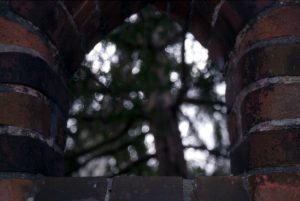

Click on an image for a larger view.
One of the most curious in the Nikon lineup, this tiny lens first appeared in 1968 and was specially designed for use with manual flash units. It automates the guide number calculation you have to use with manual flash. This is achieved by coupling the aperture and focusing mechanisms, such that the aperture is stopped down when focusing closer, and opened up when focusing further away. The coupling can be disengaged for normal use, or for use with an automatic flash unit.
One effect of this is that focusing direction is the reverse of that found on all other F-mount Nikkors. Also, the amount of extension is non-linear with angle of rotation.
It has guide number settings of 80/250, 63/200, 50/160, 40/125, 32/100, 25/80, 20/63, 16/50, 13/40, and 10/32 (meters/feet).
Another feature directed at flash use was the 7-bladed aperture that formed a nearly round opening around F8. This was supposed to make reflected highlights, which often occur in flash photography, look more pleasing. When stopping down further, the aperture does not stay round, however. As you can see in the sample shot, the out-of-focus highlights are indeed round, but have the usual Nikkor bright-circle bokeh.
The lens is a Tessar design of 4 elements in 3 groups, and is a reasonably good performer. It is supposedly inferior in resolution and contrast to the 50mm Nikkors, but I have not done direct comparisons. For moderate enlargements and hand-held shots, you certainly won't have to worry about performance.
As far as I am aware, there is just one optical version of this lens - the only change was made in 1973 when integrated coating was added. The new Nikkor 45mm 2.8P lens has similar, but not identical, optics.


Click on an image for a larger view.
I did not note down the aperture used in these shots, but think it was F4-5.6 in both cases.